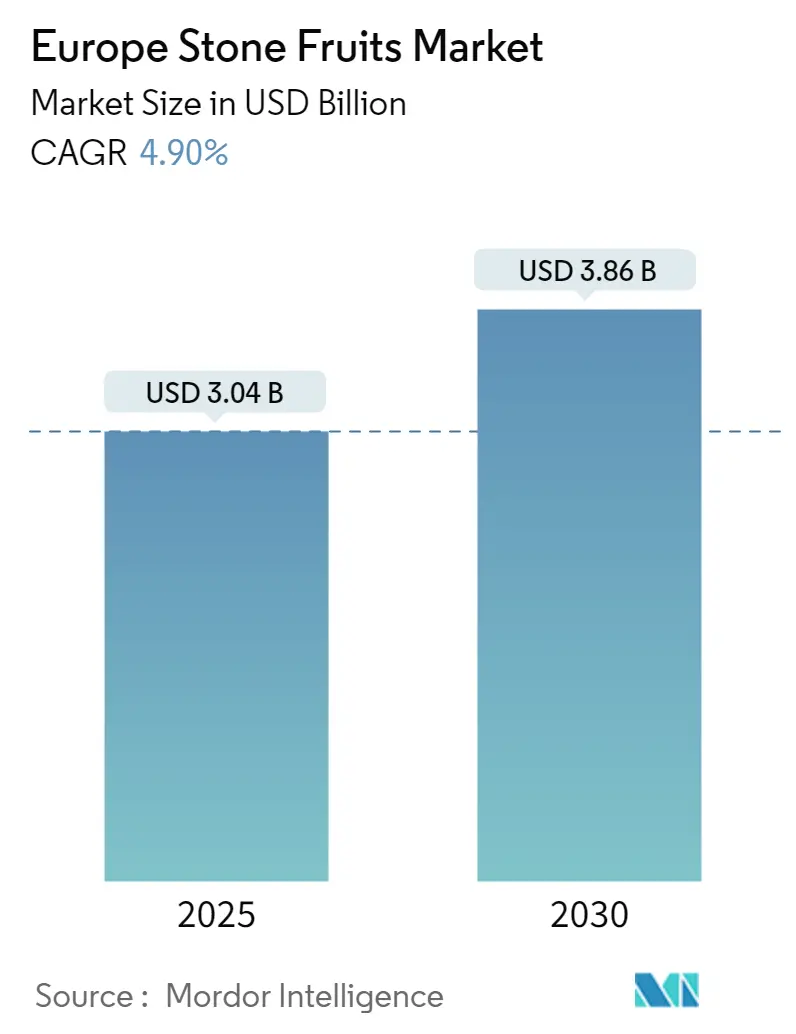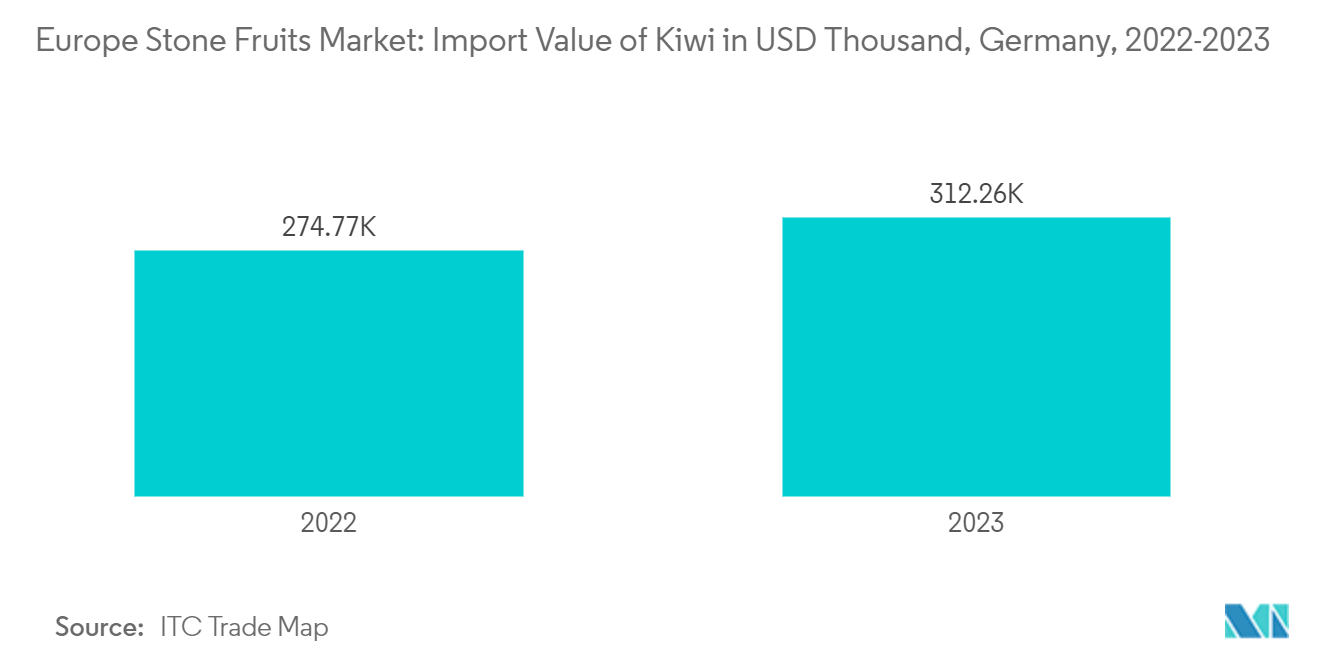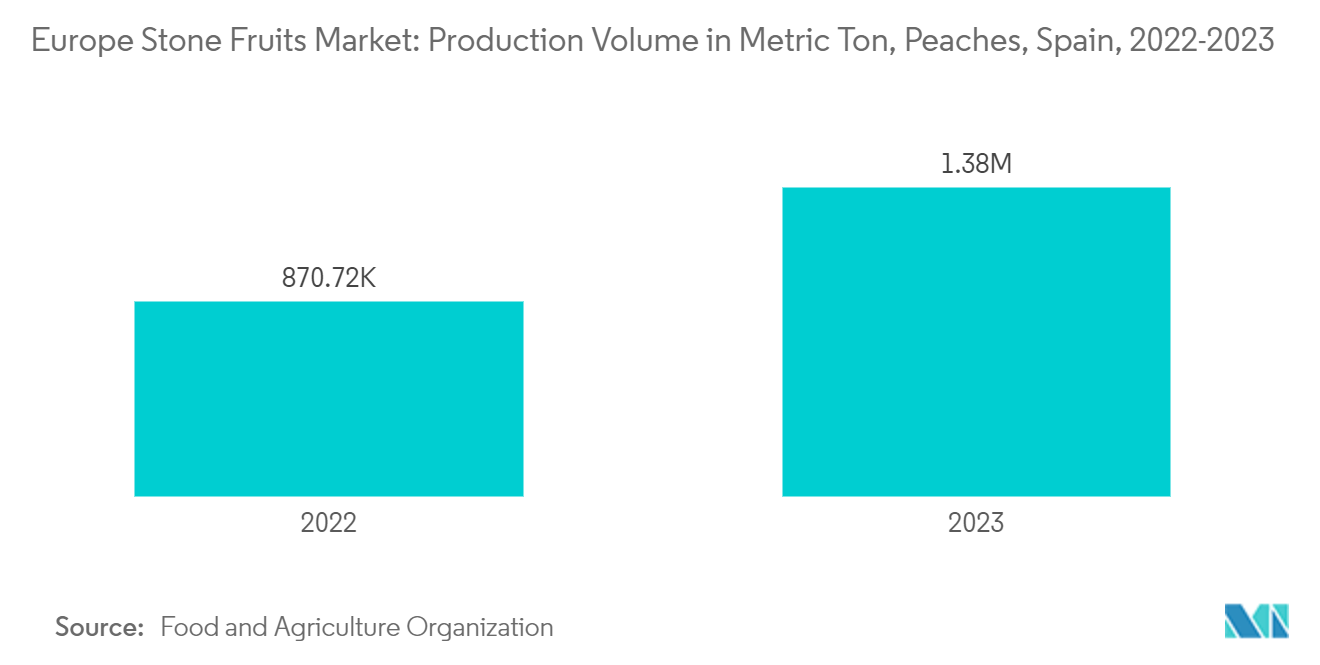Europe Stone Fruits Market Size and Share

Europe Stone Fruits Market Analysis by Mordor Intelligence
The Europe Stone Fruits Market size is estimated at USD 3.04 billion in 2025, and is expected to reach USD 3.86 billion by 2030, at a CAGR of 4.9% during the forecast period (2025-2030).
Apricots, cherries, peaches, and nectarines constitute the primary stone fruits cultivated in Europe. The increasing urbanization and consumer preference for organic fruits over conventional varieties, driven by heightened health consciousness, have increased the demand for stone fruits in Europe. The robust regional trade network, supported by substantial domestic production, further strengthens market growth. Germany, Italy, France, and Spain represent key markets for stone fruits in Europe, with Spain maintaining its position as the region's largest producer of peaches and nectarines.
Stone fruit production occurs primarily in Spain's Aragon, Catalonia, and Murcia regions, with expanding production in Extremadura, Andalusia, and Valencia. The growth in Spanish production is attributed to increased planted area and favorable climate conditions. Tourism growth in the region is driving higher demand for stone fruits. According to the European Commission, tourist accommodation nights increased from 1.83 billion in 2021 to 2.72 billion in 2022 post-pandemic. This tourism growth is anticipated to boost the consumption of cherries, peaches, and nectarines, driving market growth during the forecast period.
The consumption of fresh fruits, including stone fruits, in Europe faces challenges due to high inflation stemming from the Ukraine conflict, which may affect market growth. However, government initiatives promoting fruit consumption are anticipated to drive market expansion. In 2022, the United Kingdom implemented the EU School Fruit Scheme, with 155,000 schools participating. The program distributed over 71 million kilograms of fruits and vegetables and 167 million liters of milk to European children, supported by USD 199.7 million from the EU budget. This initiative aims to increase fresh fruit consumption, including stone fruits, which is projected to boost regional production and support market growth during the forecast period.
Europe Stone Fruits Market Trends and Insights
Increase in Health Consciousness Among Consumers Drives the Demand for Stone Fruits
The European market for fresh fruits, particularly stone fruits, is experiencing growth due to increasing consumer preference for healthy food choices. The rising demand is reflected in the higher import volumes across European regions in recent years. Stone fruits like apricots, cherries, and peaches have gained significant market share in Western Europe, with Germany, Italy, Spain, and the United Kingdom emerging as key markets.
Growing awareness of stone fruits' nutritional benefits, including their high vitamin content, antioxidants, and fiber, has increased their consumption. Stone fruits align with current dietary preferences that emphasize fresh, whole foods for weight management, immunity enhancement, and overall health improvement. The preference for natural and organic foods has positioned stone fruits, particularly organically grown varieties, as healthier alternatives to processed snacks. The marketing of stone fruits as functional foods with specific health benefits, such as improved digestion and reduced inflammation, has further increased their appeal. This heightened health consciousness has increased the demand for fresh fruits, including stone fruits in Portugal. Import data reflects this trend, with the ITC Trade Map reporting that Portugal's apricot imports rose from 2,039 metric tons in 2022 to 3,004 metric tons in 2023. This increase in stone fruit imports is projected to support market growth in the future.
Fresh fruit consumption is shifting toward sustainable production and processing methods. Consumers are increasingly focused on locally produced fruits and their environmental impact. This trend has led to increased organic stone fruit production in the region. Consumer preferences for seasonal fruits and their distinct taste have increased the demand for stone fruits. The growing emphasis on healthy eating habits among European consumers is anticipated to drive market growth during the forecast period.

Spain Dominates the Market
Stone fruit production is economically significant in Spain, with cultivation spanning diverse geographical and climatic regions across the country. The primary stone fruits grown include apricots, cherries, peaches, and nectarines. Major production areas are concentrated in the south and along the Mediterranean coast, with Murcia, Aragon, Extremadura, and Catalonia leading production. According to the Food and Agriculture Organization of the United Nations (FAO), Spain's peach production increased from 0.8 million metric tons in 2022 to 1.3 million metric tons in 2023.
Spain's peach industry has improved through advancements in cultivation techniques, variety selection, and marketing systems, strengthening its position in the global market. In 2024, researchers at the National Robotarium developed an AI system that uses smartphone images to count flowers on fruit trees. The system predicts crop yields with 90% accuracy, an improvement over traditional manual methods that have 30-50% error margins. This accurate flower counting enables farmers to forecast harvest sizes for months, allowing better resource management for water usage, labor allocation, and logistics planning in Spain's peach orchards.
Government policies, including the "Plan for the improvement of the stone fruit sector" by Spain's Ministry of Agriculture, have supported regional production growth. In 2022, Spain implemented Royal Decree-Law 4/2022, establishing a EUR 10 million (USD 11 million) interest payment subsidy program to support agricultural investments, including stone fruit production. The program provides bonuses to financial institutions that have extended loans to agricultural enterprises. The initiative aims to impact loans valued at over EUR 100 million (USD 110 million). Spain primarily exports stone fruits to European countries, with Germany, the United Kingdom, the Netherlands, and Poland being the major importers. The combination of high domestic production and supportive government policies indicates continued market growth during the forecast period.

Recent Industry Developments
- 2023: The Council of Ministers of Spain has approved urgent support which includes subsidizing up to 70% of the cost of policies for drought risk in rainfed extensive arable crops, including kiwi. This support by the government is going to support the production of kiwi fruit in the country.
- October 2023: Fresh Del Monte partnered with Zag Heroez Miraculous for a limited edition promotion of its 'Kiwi Origin South Europe' campaign. The promotion features Del Monte kiwifruit sourced exclusively from Europe in three varieties such as green, gold, and red.
Europe Stone Fruits Market Report Scope
A fruit with flesh or pulp, enclosing a stone, such as a peach, plum, or cherry. They all belong to the genus prunes and are considered stone fruit. They are also known as drupes, which refer to a fleshy fruit with a hard inner layer, or stone, that surrounds the seed. The European stone fruits market covers the extensive study of Production Analysis (Volume), Consumption Analysis (Volume and Value), Import Analysis (Volume and Value), Export Analysis (Volume and Value), and Price Trends Analysis (Value). The market is segmented by Fruit Type (Peaches, Nectarines, Apricots, Plums, and Kiwi), and Geography (Italy, France, Spain, Hungary, Greece, Romania, Poland, Germany, Austria, and Portugal). The report offers market size and forecasts in terms of value (USD) and volume (Metric Tons) for all the above-mentioned segments.
| Peaches |
| Nectarines |
| Apricots |
| Plums |
| Kiwi |
| Italy | Production Analysis |
| Consumption Analysis (Volume and Value) | |
| Import Market Analysis (Volume and Value) | |
| Export Market Analysis (Volume and Value) | |
| Price Trend Analysis | |
| France | Production Analysis |
| Consumption Analysis (Volume and Value) | |
| Import Market Analysis (Volume and Value) | |
| Export Market Analysis (Volume and Value) | |
| Price Trend Analysis | |
| Spain | Production Analysis |
| Consumption Analysis (Volume and Value) | |
| Import Market Analysis (Volume and Value) | |
| Export Market Analysis (Volume and Value) | |
| Price Trend Analysis | |
| Hungary | Production Analysis |
| Consumption Analysis (Volume and Value) | |
| Import Market Analysis (Volume and Value) | |
| Export Market Analysis (Volume and Value) | |
| Price Trend Analysis | |
| Greece | Production Analysis |
| Consumption Analysis (Volume and Value) | |
| Import Market Analysis (Volume and Value) | |
| Export Market Analysis (Volume and Value) | |
| Price Trend Analysis | |
| Romania | Production Analysis |
| Consumption Analysis (Volume and Value) | |
| Import Market Analysis (Volume and Value) | |
| Export Market Analysis (Volume and Value) | |
| Price Trend Analysis | |
| Poland | Production Analysis |
| Consumption Analysis (Volume and Value) | |
| Import Market Analysis (Volume and Value) | |
| Export Market Analysis (Volume and Value) | |
| Price Trend Analysis | |
| Germany | Production Analysis |
| Consumption Analysis (Volume and Value) | |
| Import Market Analysis (Volume and Value) | |
| Export Market Analysis (Volume and Value) | |
| Price Trend Analysis | |
| Austria | Production Analysis |
| Consumption Analysis (Volume and Value) | |
| Import Market Analysis (Volume and Value) | |
| Export Market Analysis (Volume and Value) | |
| Price Trend Analysis | |
| Portugal | Production Analysis |
| Consumption Analysis (Volume and Value) | |
| Import Market Analysis (Volume and Value) | |
| Export Market Analysis (Volume and Value) | |
| Price Trend Analysis |
| Fruit Type | Peaches | |
| Nectarines | ||
| Apricots | ||
| Plums | ||
| Kiwi | ||
| Geography | Italy | Production Analysis |
| Consumption Analysis (Volume and Value) | ||
| Import Market Analysis (Volume and Value) | ||
| Export Market Analysis (Volume and Value) | ||
| Price Trend Analysis | ||
| France | Production Analysis | |
| Consumption Analysis (Volume and Value) | ||
| Import Market Analysis (Volume and Value) | ||
| Export Market Analysis (Volume and Value) | ||
| Price Trend Analysis | ||
| Spain | Production Analysis | |
| Consumption Analysis (Volume and Value) | ||
| Import Market Analysis (Volume and Value) | ||
| Export Market Analysis (Volume and Value) | ||
| Price Trend Analysis | ||
| Hungary | Production Analysis | |
| Consumption Analysis (Volume and Value) | ||
| Import Market Analysis (Volume and Value) | ||
| Export Market Analysis (Volume and Value) | ||
| Price Trend Analysis | ||
| Greece | Production Analysis | |
| Consumption Analysis (Volume and Value) | ||
| Import Market Analysis (Volume and Value) | ||
| Export Market Analysis (Volume and Value) | ||
| Price Trend Analysis | ||
| Romania | Production Analysis | |
| Consumption Analysis (Volume and Value) | ||
| Import Market Analysis (Volume and Value) | ||
| Export Market Analysis (Volume and Value) | ||
| Price Trend Analysis | ||
| Poland | Production Analysis | |
| Consumption Analysis (Volume and Value) | ||
| Import Market Analysis (Volume and Value) | ||
| Export Market Analysis (Volume and Value) | ||
| Price Trend Analysis | ||
| Germany | Production Analysis | |
| Consumption Analysis (Volume and Value) | ||
| Import Market Analysis (Volume and Value) | ||
| Export Market Analysis (Volume and Value) | ||
| Price Trend Analysis | ||
| Austria | Production Analysis | |
| Consumption Analysis (Volume and Value) | ||
| Import Market Analysis (Volume and Value) | ||
| Export Market Analysis (Volume and Value) | ||
| Price Trend Analysis | ||
| Portugal | Production Analysis | |
| Consumption Analysis (Volume and Value) | ||
| Import Market Analysis (Volume and Value) | ||
| Export Market Analysis (Volume and Value) | ||
| Price Trend Analysis | ||
Key Questions Answered in the Report
How big is the Europe Stone Fruits Market?
The Europe Stone Fruits Market size is expected to reach USD 3.04 billion in 2025 and grow at a CAGR of 4.90% to reach USD 3.86 billion by 2030.
What is the current Europe Stone Fruits Market size?
In 2025, the Europe Stone Fruits Market size is expected to reach USD 3.04 billion.
What years does this Europe Stone Fruits Market cover, and what was the market size in 2024?
In 2024, the Europe Stone Fruits Market size was estimated at USD 2.89 billion. The report covers the Europe Stone Fruits Market historical market size for years: 2019, 2020, 2021, 2022, 2023 and 2024. The report also forecasts the Europe Stone Fruits Market size for years: 2025, 2026, 2027, 2028, 2029 and 2030.
Page last updated on:
Europe Stone Fruits Market Report
Statistics for the 2025 Europe Stone Fruits market share, size and revenue growth rate, created by Mordor Intelligence™ Industry Reports. Europe Stone Fruits analysis includes a market forecast outlook for 2025 to 2030 and historical overview. Get a sample of this industry analysis as a free report PDF download.


